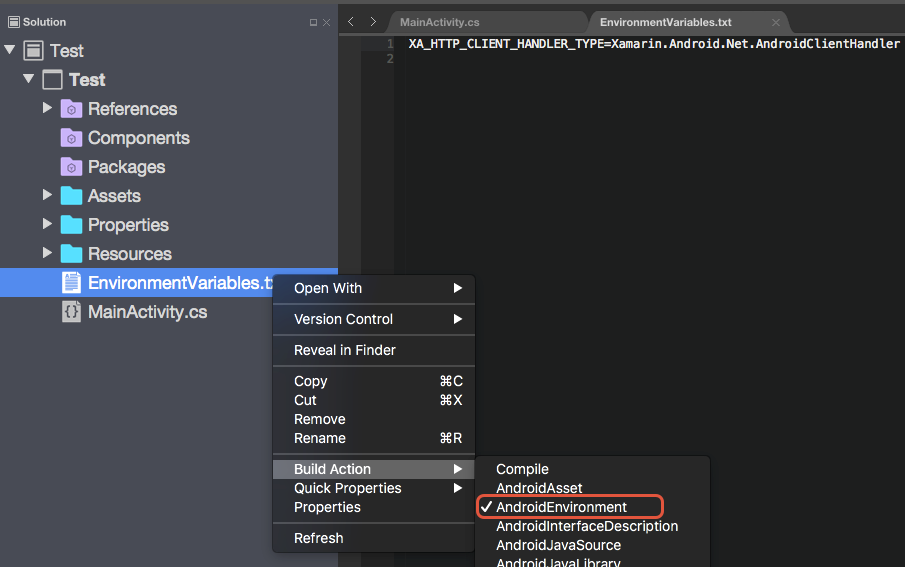HttpClient Stack and SSL/TLS Implementation Selector for Android
The HttpClient Stack and SSL/TLS Implementation selectors determine the HttpClient and SSL/TLS implementation that will be used by your Xamarin.Android apps.
Projects must reference the System.Net.Http assembly.
Warning
April, 2018 – Due to increased security requirements, including PCI compliance, major cloud providers and web servers are expected to stop supporting TLS versions older than 1.2. Xamarin projects created in previous versions of Visual Studio default to use older versions of TLS.
In order to ensure your apps continue to work with these servers and services, you should update your Xamarin projects with the Android HttpClient and Native TLS 1.2 settings shown below, then re-build and re-deploy your apps to your users.
The Xamarin.Android HttpClient configuration is in Project Options > Android Options, then click the Advanced Options button.
These are the recommended settings for TLS 1.2 support:
Alternative configuration options
AndroidClientHandler
AndroidClientHandler is the new handler that delegates to native Java/OS code instead of implementing everything in managed code. This is the recommended option.
Pros
- Use native API for better performance and smaller executable size.
- Support for the latest standards, eg. TLS 1.2.
Cons
- Requires Android 4.1 or later.
- Some HttpClient features/options are not available.
Managed (HttpClientHandler)
Managed handler is the fully managed HttpClient handler that has been shipped with previous Xamarin.Android versions.
Pros
- It is the most compatible (features) with MS .NET and older Xamarin versions.
Cons
- It is not fully integrated with the OS (eg. limited to TLS 1.0).
- It is usually much slower (eg. encryption) than native API.
- It requires more managed code, creating larger applications.
Choosing a Handler
The choice between AndroidClientHandler and HttpClientHandler
depends upon the needs of your application. AndroidClientHandler is
recommended for the most up-to-date security support, eg.
- You require TLS 1.2+ support.
- Your app is targeting Android 4.1 (API 16) or later.
- You need TLS 1.2+ support for
HttpClient. - You don't need TLS 1.2+ support for
WebClient.
HttpClientHandler is a good choice if you need TLS 1.2+ support but
must support versions of Android earlier than Android 4.1. It is also a
good choice if you need TLS 1.2+ support for WebClient.
Beginning with Xamarin.Android 8.3, HttpClientHandler defaults to
Boring SSL (btls) as the underlying TLS provider. The Boring SSL
TLS provider offers the following advantages:
- It supports TLS 1.2+.
- It supports all Android versions.
- It provides TLS 1.2+ support for both
HttpClientandWebClient.
The disadvantage of using Boring SSL as the underling TLS provider is that it can increase the size of the resulting APK (it adds about 1MB of additional APK size per supported ABI).
Beginning with Xamarin.Android 8.3, the default TLS provider is Boring
SSL (btls). If you do not want to use Boring SSL, you can revert to
the historical managed SSL implementation by setting the
$(AndroidTlsProvider) property to legacy (for more information
about setting build properties, see
Build Process).
Programatically Using AndroidClientHandler
The Xamarin.Android.Net.AndroidClientHandler is an
HttpMessageHandler implementation specifically for Xamarin.Android.
Instances of this class will use the native java.net.URLConnection
implementation for all HTTP connections. This will theoretically
provide an increase in HTTP performance and smaller APK sizes.
This code snippet is an example of how to explicitly for a single
instance of the HttpClient class:
// Android 4.1 or higher, Xamarin.Android 6.1 or higher
HttpClient client = new HttpClient(new Xamarin.Android.Net.AndroidClientHandler ());
Note
The underlying Android device must support TLS 1.2 (ie. Android 4.1 and later). Please note that the official support for TLS 1.2 is in Android 5.0+. However some devices support TLS 1.2 in Android 4.1+.
SSL/TLS implementation build option
This project option controls what underlying TLS library will be used
by all web request, both HttpClient and WebRequest. By default, TLS
1.2 is selected:
For example:
var client = new HttpClient();
If the HttpClient implementation was set to Managed and the TLS
implementation was set to Native TLS 1.2+, then the client object
would automatically use the managed HttpClientHandler and TLS 1.2
(provided by the BoringSSL library) for its HTTP requests.
However, if the HttpClient implementation is set to
AndroidHttpClient, then all HttpClient objects will use the
underlying Java class java.net.URLConnection and will be unaffected
by the TLS/SSL implementation value. WebRequest objects would use
the BoringSSL library.
Other ways to control SSL/TLS configuration
There are three ways that a Xamarin.Android application can control the TLS settings:
- Select the HttpClient implementation and default TLS library in the Project Options.
- Programatically using
Xamarin.Android.Net.AndroidClientHandler. - Declare environment variables (optional).
Of the three choices, the recommended approach is to use the
Xamarin.Android project options to declare the default
HttpMessageHandler and TLS for the entire app. Then, if necessary,
programmatically instantiate Xamarin.Android.Net.AndroidClientHandler
objects. These options are described above.
The third option – using environment variables – is explained below.
Declare Environment Variables
There are two environment variables that are related to the use of TLS in Xamarin.Android:
XA_HTTP_CLIENT_HANDLER_TYPE– This environment variable declares the defaultHttpMessageHandlerthat the application will use. For example:XA_HTTP_CLIENT_HANDLER_TYPE=Xamarin.Android.Net.AndroidClientHandlerXA_TLS_PROVIDER– This environment variable will declare which TLS library will be used, eitherbtls,legacy, ordefault(which is the same as omitting this variable):XA_TLS_PROVIDER=btls
This environment variable is set by adding an environment file to the project. An environment file is a Unix-formatted plain-text file with a build action of AndroidEnvironment:
Please see the Xamarin.Android Environment guide for more details about environment variables and Xamarin.Android.





